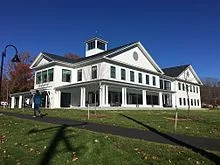Michele Perkins: Small colleges can still prosper
The John Lyons Academic Center on the New England College campus.
Via the New England Board of Higher Education (nebhe.org)
In New England and in several other regions of the country, it’s only natural to be concerned about the fiscal challenges confronting our nation’s private colleges and universities. Forecasts by prominent higher education experts increasingly suggest that many, if not most, of our small private institutions will face closure in the decade ahead. However, Inside Higher Ed recently reconsidered this angle in a piece titled “Healthier Than Imagined?” The article profiles a recently released research report commissioned by the Council of Independent Colleges (CIC) and concludes that the projected demise of small, private colleges may, in fact, be overblown.
New England College (NEC), which was mentioned in the Inside Higher Ed article, contradicts the assertion that most, if not all, small, tuition-dependent liberal arts colleges are failing. Our college is succeeding in this economy and experiencing substantial budget surpluses. At a time when many institutions are struggling to balance their budgets, NEC will post an unrestricted operating surplus of about $800,000 for FY2017 on an operating budget of $57 million. We anticipate growing that surplus to $1 million in the 2018 fiscal year.
While I’m happy to report these numbers, I unfortunately do not have any “secret sauce” recipe to share about how we are doing this in very challenging times and in an era of severely declining demographics. Honestly, the short answer to our success can be described in a few phrases: We are creative; we are unafraid to embrace change and to change in major ways; we are open to intelligent risk-taking; and we are willing to put in the time and effort to make it happen. Everyone at the college shares these values; everyone must share these values to succeed.
We also are clear on what is timeless and not up for modification or elimination— such as the liberal arts. I firmly believe you can do both–embrace innovation and remain faithful to the liberal arts—and we are here to prove it. At NEC, we plan to grow our traditional residential undergraduate enrollment from an expected 1,060 this fall to 1,500 over the next several years—during a period of declining K-12 enrollments (estimated as high as 15% over the next decade by the National Center for Education Statistics). New England College’s enrollment trends project growth, not decline.
NEC’s residential, undergraduate programs don’t currently pay for themselves; operating surpluses are driven by other programs such as online education and graduate programs, which push total enrollment to about 2,700. We know that our traditional undergraduate programs must grow to about 1,300 students to break even financially. To grow our undergraduate numbers in the face of declining high school populations, we looked outside our region.
New England College recruits in secondary markets including New York City and all the Mid-Atlantic states, and we are developing markets in western and southern states. In recent years, we have seen increased enrollment and, with over 35% of our residential undergraduate students from underrepresented populations, NEC now has the largest diversity percentage of any college or university in New Hampshire–public or private.
A final note about enrollment size: The CIC report found that a group of the smallest private colleges—those with fewer than 1,000 students enrolled—have posted consistently weaker financial performance than larger peers through both good times and bad. The data consistently show that if an institution has enrollment under 1,000 students, then it is more difficult to keep the doors open. New England College recognized that there are many opportunities to provide a quality education beyond the traditional student population and crossed the 1,000-student threshold long ago.
As the Inside Higher Ed article correctly points out, NEC has kept its debt levels low, embracing a highly conservative debt strategy for many years and only taking on additional debt in the last few years. We have managed annual budgets conservatively, including leaving some faculty and staff positions unfilled in some years and offering voluntary retirement packages a few years ago, all this while meeting the public’s demand for new program offerings. We have learned to be “Yankee Frugal” in our budget, while also working to be resourceful and creative.
In this environment, some business and political leaders question the role of the liberal arts in this changing economy. While we recognize and actively promote the need for “real-world” learning, we remain undeterred in our belief that a well-rounded education will best serve students as they progress through multiple projected career paths, often in jobs that don’t yet exist. Other concerns also include the evolving policy on immigration that may hurt institutions’ ability to enroll the international students that have increasingly become a financial lifeline.
If we enrolled only traditional, residential undergraduates—with all the services we provide, it would simply not be viable. Given the volatility of higher education enrollment markets, changing student preferences, economic shifts and changing demand for various course offerings, flexibility is essential. We are also struggling to deal with our "discount rate"—the amount colleges increasingly reduce tuition through scholarships in order to attract students without causing inappropriate levels of student debt.
It hasn’t been easy, but flexibility of courses, a variety of delivery modes, online opportunities, competitive scholarships, smart marketing and being open to innovative ideas provide a model that allows us to serve NEC students and meet our academic purpose and mission.
Michele Perkins is president of New England College, in Henniker, N.H., with a total of about 2,700 undergraduate and graduate students.
